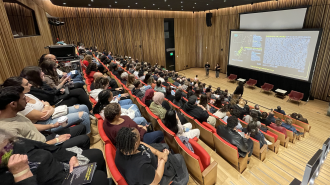
One small step for women, one giant leap for womenkind: NASA's Dr Hashima Hasan embarks on new frontier for space, science and feminism

Simply put, Dr Hashima Hassan, Deputy Program Scientist for the James Webb telescope and Educational and Public Outreach Lead for Astrophysics at NASA, is breaking new ground for female nuclear and astrophysicists.
Currently, Hashima works on monitoring and managing the science program for the James Webb telescope. But the journey to her position was not an easy one. Hashima's story is one of fortitude over adversity, breaking cultural barriers and smashing glass ceilings for female advancement in the workplace.
"At the time I was studying for my PhD and physics as a discipline was considered to be a 'male subject'. I ended up studying nuclear physics, but I had the desire to work in astrophysics too which would require me to go out at night to look at the stars," Dr Hashima tells The New Arab. "However, something as simple as star observation is fraught with cultural barriers in India and my parents wouldn't allow me to wander out alone; it was a sheltered upbringing," she adds.
"However, at the same time, certain things were in my favour. If there wasn't an all-girls college at university, I doubt my parents would have allowed me to travel at such an age to study at Oxford University."
"Science today looks much more like the face of America: different accents, different makeups, different perspectives"
When Hashima started working, demographic diversity, or lack of it, soon became evident. "When I'd attend a large conference, very often I'd be the only woman and the only one with brown skin. In the 1990s, everyone seemed to be white."
Such an environment discouraged confidence; one's presence was off-putting enough, let alone asserting one's expertise. "I was hesitant to speak out, it was tough to stand out professionally despite obviously standing out by how I looked. Issues like maternity leave were non-existent."
Throughout Dr Hashima's career, she has been a woman of firsts. Falling pregnant with her first child in 1982 whilst on a fellowship with the National Research Council, Hashima told The New Arab about what happened next.
"I called them up and said I was pregnant, what do I do? There was dead silence. This had never happened before. It says a lot that this very prestigious program had not accounted, or created contingency plans, for female scientists giving birth."
|
Hashima tells us things now are, thankfully, a lot different. "Now you see greater diversity, more equity, more inclusion. It's a lot better. Science today looks much more like the face of America: different accents, different makeups, different perspectives."
Joining NASA
Despite ongoing visa issues, a long and successful stint in academia led Dr Hashima to achieve her dream and join NASA. "I joined NASA around 1995. I managed the UV optical and gravitational astrophysics program for a while, which involved setting up working groups to define the objectives of our telescopes."
Now working at the James Webb telescope program, Hashima is very proud of what the team has achieved. "We're going to learn so much about the atmosphere of the planet: which new stars are being born, how they die. Previously, we didn't know much about them. But with the telescope, we're going to ascertain much more about their properties which will help us learn more about black holes and about dark energy."
Dr Hashima concluded, "whenever you embark on a complex program like James Webb, you're developing technology that has a lot of positive spin-offs. Materials, processes and working practices.
"For example, we have a linked program called Webb spinoffs, which has pioneered research into medical technology using beryllium, one of the materials used for the big golden mirror of the James Webb telescope as an optical measurement device. So behind every mission, there are many benefits to humanity."
Mariam Elsayeh Ibrahim is a freelance journalist and story producer currently based in the United Kingdom
Follow her on Twitter: @mariamelsaieh




 Follow the Middle East's top stories in English at The New Arab on Google News
Follow the Middle East's top stories in English at The New Arab on Google News


